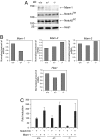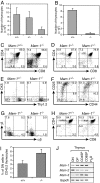Mastermind-1 is required for Notch signal-dependent steps in lymphocyte development in vivo
- PMID: 17535917
- PMCID: PMC1887568
- DOI: 10.1073/pnas.0700240104
Mastermind-1 is required for Notch signal-dependent steps in lymphocyte development in vivo
Abstract
Mastermind (Mam) is one of the elements of Notch signaling, an ancient system that plays a pivotal role in metazoan development. Genetic analyses in Drosophila and Caenorhabditis elegans have shown Mam to be an essential positive regulator of this signaling pathway in these species. Mam proteins bind to and stabilize the DNA-binding complex of the intracellular domains of Notch and CBF-1, Su(H), Lag-1 (CSL) DNA-binding proteins in the nucleus. Mammals have three Mam proteins, which show remarkable similarities in their functions while having an unusual structural diversity. There have also been recent indications that Mam-1 functionally interacts with other transcription factors including p53 tumor suppressor. We herein describe that Mam-1 deficiency in mice abolishes the development of splenic marginal zone B cells, a subset strictly dependent on Notch2, a CSL protein and Delta1 ligand. Mam-1 deficiency also causes a partially impaired development of early thymocytes, while not affecting the generation of definitive hematopoiesis, processes that are dependent on Notch1. We also demonstrate the transcriptional activation of a target promoter by constitutively active forms of Notch to decrease severalfold in cultured Mam-1-deficient cells. These results indicate that Mam-1 is thus required to some extent for Notch-dependent stages in lymphopoiesis, thus supporting the notion that Mam is an essential component of the canonical Notch pathway in mammals.
Conflict of interest statement
The authors declare no conflict of interest.
Figures





Similar articles
-
Mastermind-like 1 (MamL1) and mastermind-like 3 (MamL3) are essential for Notch signaling in vivo.Development. 2011 Dec;138(23):5235-46. doi: 10.1242/dev.062802. Development. 2011. PMID: 22069191
-
Crystal structure of the CSL-Notch-Mastermind ternary complex bound to DNA.Cell. 2006 Mar 10;124(5):985-96. doi: 10.1016/j.cell.2006.01.035. Cell. 2006. PMID: 16530045
-
More complicated than it looks: assembly of Notch pathway transcription complexes.Oncogene. 2008 Sep 1;27(38):5099-109. doi: 10.1038/onc.2008.223. Oncogene. 2008. PMID: 18758478 Review.
-
Characterization of CSL (CBF-1, Su(H), Lag-1) mutants reveals differences in signaling mediated by Notch1 and Notch2.J Biol Chem. 2012 Oct 12;287(42):34904-34916. doi: 10.1074/jbc.M112.403287. Epub 2012 Aug 22. J Biol Chem. 2012. PMID: 22915591 Free PMC article.
-
Notch signaling pathway.Sci STKE. 2006 Dec 5;2006(364):cm7. doi: 10.1126/stke.3642006cm7. Sci STKE. 2006. PMID: 17148788 Review.
Cited by
-
Regulation of innate and adaptive immunity by Notch.Nat Rev Immunol. 2013 Jun;13(6):427-37. doi: 10.1038/nri3445. Epub 2013 May 13. Nat Rev Immunol. 2013. PMID: 23665520 Review.
-
Role of Notch2 pathway in mature B cell malignancies.Front Oncol. 2023 Jan 4;12:1073672. doi: 10.3389/fonc.2022.1073672. eCollection 2022. Front Oncol. 2023. PMID: 36686759 Free PMC article. Review.
-
MAML1 enhances the transcriptional activity of Runx2 and plays a role in bone development.PLoS Genet. 2013;9(1):e1003132. doi: 10.1371/journal.pgen.1003132. Epub 2013 Jan 10. PLoS Genet. 2013. PMID: 23326237 Free PMC article.
-
The follicular versus marginal zone B lymphocyte cell fate decision.Nat Rev Immunol. 2009 Nov;9(11):767-77. doi: 10.1038/nri2656. Nat Rev Immunol. 2009. PMID: 19855403 Review.
-
Nemo-like kinase suppresses Notch signalling by interfering with formation of the Notch active transcriptional complex.Nat Cell Biol. 2010 Mar;12(3):278-85. doi: 10.1038/ncb2028. Epub 2010 Jan 31. Nat Cell Biol. 2010. PMID: 20118921
References
-
- Artavanis-Tsakonas S, Rand MD, Lake RJ. Science. 1999;284:770–776. - PubMed
-
- Weng AP, Ferrando AA, Lee W, Morris JP, IV, Silverman LB, Sanchez-Irizarry C, Blacklow SC, Look AT, Aster JC. Science. 2004;306:269–271. - PubMed
-
- Garg V, Muth AN, Ransom JF, Schluterman MK, Barnes R, King IN, Grossfeld PD, Srivastava D. Nature. 2005;437:270–274. - PubMed
-
- Mumm JS, Kopan R. Dev Biol. 2000;228:151–165. - PubMed
-
- Kumano K, Chiba S, Kunisato A, Sata M, Saito T, Nakagami-Yamaguchi E, Yamaguchi T, Masuda S, Shimizu K, Takahashi T, et al. Immunity. 2003;18:699–711. - PubMed
Publication types
MeSH terms
Substances
LinkOut - more resources
Full Text Sources
Molecular Biology Databases
Research Materials
Miscellaneous

